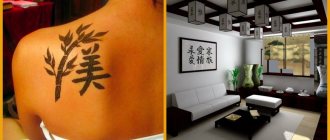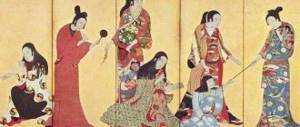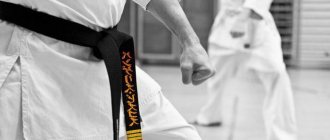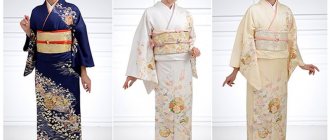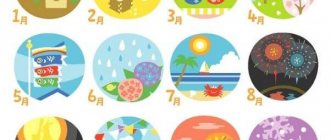At the beginning of the 21st century, interest in the cultures of Eastern countries, including Japan, has greatly increased. Original art and dissimilar traditions attract the attention of European society and Russia. Traditions include completely different aspects of people’s lives. One of the most understandable and close, and at the same time historically meaningful, can be considered the features of ethnic clothing and shoes. Traditional Japanese shoes are quite diverse. Wooden shoes are of particular interest to modern people. This is what we will talk about.
Classification of traditional Japanese shoes
As in many traditional cultures, the type of clothing and footwear depends on geographic and climatic conditions. Thus, in Japan there are two directions for the development of shoemaking:
1. Southern (southern China and southeast Asia) - wooden and wicker shoes with one intertoe loop (between 1 and 2 fingers).
2. Northern (northern China and North Korea) - resemble shoes that completely cover the feet.
And the name of Japanese wooden shoes is of particular interest to both specialists and ordinary people.
Medieval ancestor
The very first historically established types of footwear that have been established are varadzi and varadzori - “slippers” reminiscent of Russian bast shoes. The engravings of the medieval Japanese poet and artist U. Kuniyoshi helped establish this fact. The images show that such shoes were worn by Japanese samurai.
Varadzori was woven from flax fibers, from rags, from tree bark, etc. They had poor wear resistance and were very cheap. As a rule, Varadzori was worn by commoners and had a sufficient supply of pairs of shoes.
Varadzori were made in standard sizes, so the owner’s foot could hang both in front and behind the sole. The shape of the sole was oval. As a pair, the sandals were not divided into right and left, and did not have a heel, sides or toe as such. They were secured to the leg using a traditional loop and ties.
But waraji were made from straw. They were more durable, and therefore they were preferred not only by samurai, but also by monks and travelers. The bottom sole was reinforced entirely or partially with leather, straw cords, and even a metal plate.
For those who moved a lot and actively, it was important that in addition to the toe loop, waraji had additional side loops - ti and a heel loop with a bow - kaeshi. The laces were passed through the loops in such a way that they secured the foot to the sole like a side.
There are two types of waraji:
- etsuji - with four loops;
- mutsuji - with five loops.
Kanjiki can also be considered a type of wicker shoes - lattices made of woven fibers or straw, which were tied with laces to the soles of sandals to prevent feet from falling into the snow.
Waraji
Varaji are sandals woven from straw.
Varaji are sandals woven from straw. The most traditional material is rice straw. These sandals can also be worn with tabi, traditional Japanese socks with a slit. Ropes of the same material are wrapped around the ankles and securely attach the sole to the foot. During the Edo period, these practical shoes were worn by samurai and their relatives. Today, waraji is only used for festivals, cosplay, or occasionally by Buddhist monks. Waraji was oval shaped and the toes should be slightly overhanging the road.
Japanese geta shoes
This type of wooden shoes is one of the basic and most popular models for Japanese women. Traditionally, geta are Japanese shoes for walking on the street. It was invented about two centuries ago. Another name for it is “bench”. This is due to the peculiarities of its shape: a flat horizontal bar is fixed on two bars-columns, and is attached to the leg with straps or ribbons like the “flip-flops” that are well known to us. Geta are male and female.
For men's sandals, as a rule, expensive types of wood are used and the shape is different from women's models.
Women's sandals have several varieties:
- with square toe;
- with a toe slanted down (nomeri).
These sandals did not fit well on my feet. The foot did not have a secure position on the platform. This is clearly visible in the wooden shoes shown in the photo. And, besides, this type of shoe was quite heavy. In order to hold on and not lose their “shoe,” Japanese women had to move slowly and in small, frequent steps. This is how the traditional soaring and mincing gait of Japanese women was formed in culture. The Japanese geta were complemented by narrow kimonos, which also constrained the step.
Traditionally, both men's and women's wooden Japanese shoes of this type are worn on special white cotton socks, which have a separate thumb. Everyone wore tabi socks except geishas.
There is another amazing detail for the geta - a special waterproof cap for the nose, made of waterproof material and attached to the heel with laces. It is usually used in case of inclement weather.
According to their purpose and manufacturing features, they are distinguished:
- Nikkoi-geta;
- ta-geta;
- yanagi-geta - household shoes made of willow twigs for geishas;
- pokkuri-geta - luxurious, exquisitely and expensively decorated shoes for aristocratic girls;
- kiri-geta – dark color with “teeth” and flat geta for men;
- Hieri-geta - often leather-covered men's geta with thin teeth;
- sukeroku-geta - have an oval sole with a bevel in the toe area and one tooth, used in the Kabuki theater;
- tetsu-geta - geta made of iron, fastened with a chain, for training ninjas and wrestlers;
- sukeeto-geta are a kind of “skates” for skating on ice, which have blades or wires attached instead of bar teeth.
There are many names for wooden Japanese shoes. And all of them sound unusual and intriguing to Europeans.
The Japanese created "hooves" for women
Any girl will confirm that walking in high heels is quite difficult. But can you imagine wearing sandals with hooves? The Japanese were completely merciless towards the fair sex and created shoes in which you can learn to walk for months, if not years. And even when you think you've become a pro at this, you'll still be haunted by the threat of spraining your ankle with one wrong step.
These unique shoes were created by the Japanese company Walpurgis based on traditional models. The sandals are made of wood and come with red, black or white ribbons.
Views: 16,427
Share link:
- Tweet
- Share posts on Tumblr
- Telegram
- More
- by email
- Seal
Nikkoi-geta
This modification was created specifically for mountainous areas where Japanese monasteries are located and there is snow. To ensure that the feet did not slip, did not freeze, and their position was stable, two types of shoes were combined: geta and zori. A woven zori sole was attached to a variant of the wooden geta sole, forming a platform at the toe and a wide heel-like block under the heel. The laces are attached in the toe area and on the sides in such a way that they are not threaded through the entire thickness of the sole and are not attached to the sides, but are sewn between the straw sole and the wooden platform. These sandals keep you cool in hot weather and warm in cold weather.
Tabi in sports fashion
Recently, the tabi entered the Nike ISPA line and became the most anticipated model of the Reebok x Maison Margiela collaboration. At the same time, just a few years ago, shoes with a split toe were associated not with sneaker culture or streetwear, but with intellectual fashion and, first of all, with the fashion house Maison Margiela.
View this post on Instagram
In 1996, Nike released the first iteration of the Tabi, the Air Rift. The hybrid of sneakers and sandals with thick rubber soles was liked by many people, who began to buy tabi from all possible platforms. For two decades, Nike's tabi has remained a top seller on eBay.
View this post on Instagram
In 2014, Nike resumed production of tabi, but in limited quantities. The limited collection of sneakers with high shock-absorbing soles and a side plastic tie instead of laces has become the dream of every sneakerhead. The production of tabi at Nike has grown into a whole line called ISPA.
Why do sneakers exist only in Russia?
Ta-geta
This type of Japanese wooden shoes existed 2 thousand years ago. Peasants working in flooded areas harvesting rice needed to protect their feet from moisture and injury. Therefore, the simplest way was to tie planks to the feet. They were tied to the leg by passing the cords through special holes. This type of shoe was not light and elegant, and with dirt stuck to it, it became completely unbearable. Special ropes were used to control them. And to work at sea, they wore a type of ta-geta - nori-geta, which had two tiers. Large stones were tied to the bottom one so that a person could move along the bottom and not float up. And after World War II, the Japanese wore o-ashi, a type of ta-geta.
Shoe traditions of Japan
Below is a list of Japanese shoe traditions:
— When entering a house, shoes must be taken off . The Japanese, like the Russians, are very surprised when they see Europeans and Americans who can keep their shoes on almost the whole day and move around their living space in them. For clean residents of the Land of the Rising Sun, this is unacceptable, as a result of which shoes are usually left at the door.
— Cleanliness and tidiness are important . You will have to try hard to find a person in Japan who is willing to wear dirty or downright shabby shoes. Typically, locals regularly clean out their wardrobe items and replace them with something new when the situation demands.
— There should be a lot of shoes . The Japanese have a lot of shoes. For example, when visiting, a person may be offered soft slippers (surippa), but when going to the restroom, he will have to change into special slippers. It is also not customary to come to special occasions in casual shoes, and for visiting sacred temples there is even a separate pair that is not worn on other occasions. As a result, the average Japanese person may have dozens of pairs of shoes in their wardrobe.
— National shoes are relevant only on holidays . Considering the fact that traditional Japanese shoes (discussed below) are not very comfortable, they are usually worn only during holidays. In combination with a kimono and other similar clothing, it looks extremely attractive.
Okobo
This type of Japanese shoe is a type of pokkuri-geta. It is intended for geisha apprentices and consists of high-soled shoes with a beveled angle at the toe. Their height fluctuated around 14 cm. However, the highest-ranking geisha also wore very high okobos, such that it was almost impossible to move without assistance. The advantage of this type of shoes was that it was possible to walk in a fairly serious layer of mud without getting your feet dirty. But if we remember the peculiarities of the climatic conditions of Japan, then numerous rivers, often overflowing their banks, carry with them a lot of dirt, which they leave behind when going back to their channel.
Pokkuri Okobo
Pokkuri. Young girls wear them on special occasions. Ppokuri is an onomatopoeia for the sound these shoes make. Their interior is hollow and may contain small peas for noise, so the wearer makes a sound when walking. They are usually used with tabi. Maiko (apprentice geisha) often wear okobo pokkuri. These geta increase the maiko's height and ensure that she walks with small, easy steps. The color of the straps indicates the maiko's rank or experience, starting with red (hanao) and ending with yellow (maiko), just before becoming a full geisha. Geisha do not wear okobos, they wear standard getas or zoris.
Pokkuri and Koppori are usually very fancy and worn by little girls on shichi-go-san (7-5-3), which is a celebration for the ages of 7, 5 and 3 years. Maiko shoes are very expensive and hard to find.
Zori
This type of Japanese wooden shoe is shown in the photo. He is very similar to geta. Previously, it was made only from wood, but now a variety of materials are used to make zori: from straw to synthetic plastics. The main feature that distinguishes zori from geta is the presence of a large thickening of the platform at the heel and its almost complete absence in the toe area. Zori are quite comfortable and practical shoes and are suitable for everyday wear. However, modern Japanese women, since we are talking about the female type of wooden Japanese shoes, prefer to wear soft shoes in everyday life, and wear traditional sandals only on special occasions.
At their core, zori are modernized waraji. Japanese warriors wore asinaka, a type of zori without heels. The toes and heel protrude beyond the sole.
Zouri - 草履
Zori
The spelling of dawn varies greatly. Zori are the best choice for a kimono, but they can also be worn with a yukata. Most Japanese women wear zori with a kimono.
Zori is a thong, usually with a wedge heel, although sometimes with a flat sole. The most common traditional zori are made from straw, known as tatami, however, cloth, lacquered wood and leather are also used. In recent years, they have been made by the Chinese from synthetic materials.
Shigure zori Covered toe zori are called shigure and are worn on cold or rainy days
Traditionally, Zoris are short, but modern styles can have platforms of varying heights. More informal zoris usually have black or colored "thongs", while formal styles are white. The part of the strap is called the hanao and can usually be replaced if it is damaged or needs alteration. The thong between the toes is believed to put pressure on acupressure points to help the body.
Dawns for girls.
Tabi
Tabi was already mentioned above as socks that are worn under geta or sometimes under zori. However, the Japanese consider tabi as a separate type of shoe, not wooden, but made of cotton. Tabis have a special recess for the strap, which makes them very convenient to use.
A type of tabi - jiko-tabi - is more similar to a shoe, since here a rubber sole is added to the traditional tabi. These shoes allow you to walk without other shoes, even on wet soil. In addition, jiko-tabi do not allow you to slip when working on slippery surfaces, as they have special grooves on the sole that help provide better grip for your fingers.
Jika-Tabi
Tabi boots with rubber soles.
Jika Tabi was invented and popularized in the 20th century. These outdoor shoes are modeled after the tabi, which is why they are called "tabi boots" in English. They are sometimes used by people working outdoors, such as rickshaw pullers, who need to move quickly and grip the road, which would be difficult in traditional sandals. They are also popular among Japanese builders.
Japanese home shoes
Changing shoes when entering a Japanese house is a long-standing and very persistent tradition of Japanese culture. National versions of slippers are being used instead. A long time ago, the Japanese did not use shoes at home at all - they walked barefoot. Over time, they began to use white tabi socks as house shoes.
And later surippa appeared. Soft house shoes that act as slippers are very loved by the Japanese. It gives them a feeling of peace and tranquility, coziness and comfort.
One of the varieties of surippa is toire surippa, or in other words, “toilet slippers.” They are worn instead of a surippa when entering a toilet or bathroom. They are made of plastic or rubber, and sometimes lined with soft fabric on top.
There is another type of once popular Japanese indoor shoes - shitsunaibaki. Most often they are used in the cold season, as they are made from very dense cotton or wool. Outwardly, they resemble socks. Similar socks were previously used for training in martial arts.


